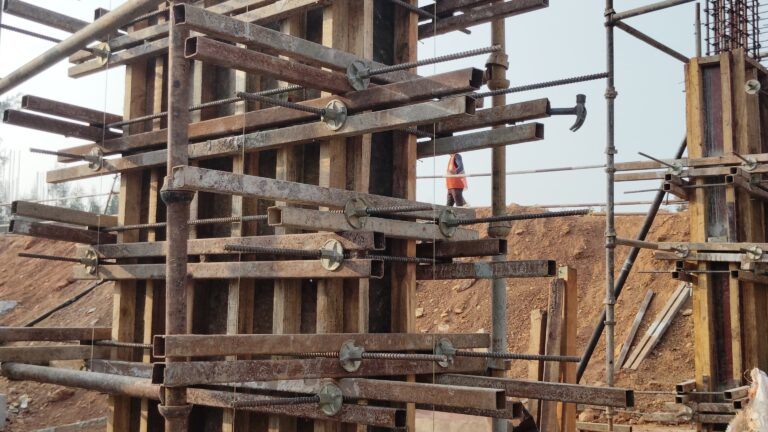In a world where construction is both a necessity and a responsibility, the materials we choose shape our buildings and our future. Traditional materials like plywood have long dominated the industry, yet they have inherent flaws—warping, water damage, and environmental degradation. But what if there was a better way? A solution that offers durability, sustainability, and superior performance?
Enter Plastic Ply, a game-changing alternative that is revolutionising formwork across the globe. This innovation is not just a step forward; it’s a leap towards a more resilient and eco-conscious construction industry.
The Problem with Traditional Plywood in Formwork
Plywood has been a staple in formwork for decades, yet it struggles with challenges that make it inefficient in the long run.
🔴 Water Damage & Warping
Plywood absorbs moisture over time, leading to swelling, warping, and ultimately reducing its usability in construction.
🔴 Limited Reusability
On average, plywood formwork lasts around 10 repetitions before it becomes unusable, leading to frequent replacements and increasing project costs.
🔴 Environmental Cost
Millions of trees are felled annually to produce plywood. This contributes to deforestation, habitat destruction, and increased carbon emissions.
🔴 Termite & Fungus Attacks
Unlike plastic ply, plywood is susceptible to termites, fungal growth, and rotting, making it an unreliable choice in humid or damp environments.
So, how do we build smarter, stronger, and more sustainably? The answer lies in plastic plywood alternative solutions.
Plastic Ply: The Future of Waterproof Formwork
Unlike traditional plywood, plastic shuttering sheets offer a waterproof, durable, and eco-friendly alternative that outperforms in every aspect. Here’s why plastic ply is the superior choice for modern formwork applications:
1️⃣ 100% Waterproof & Weather Resistant
Plastic shuttering does not absorb water, making it ideal for high-humidity conditions, rain-prone areas, and concrete curing processes. Unlike plywood, which swells and loses shape when wet, plastic ply maintains its structural integrity.
2️⃣ Reusability & Cost Efficiency
Plastic formwork materials can be used for over 50 repetitions, significantly reducing material replacement costs and waste generation. This high reusability factor makes it a long-term investment rather than a recurring expense.
3️⃣ Unmatched Strength & Durability
Whether it’s shuttering plastic panels for slabs, beams, or columns, plastic formwork sheets offer excellent load-bearing capacity. They are resistant to cracks, breakage, and deformations, ensuring stability and precision in every pour.
4️⃣ Eco-Friendly & Recycled
Most plastic shuttering boards are made from recycled plastic sheets, giving discarded waste a second life in construction. This actively reduces landfill waste and helps conserve forests, making plastic ply a responsible and sustainable choice.
5️⃣ No Termite or Fungus Issues
Unlike plywood, plastic ply boards are immune to termites, fungal growth, and decay. This eliminates the need for expensive chemical treatments and frequent replacements, adding to their economic and environmental benefits.
How Plastic Ply is Transforming Formwork Across Applications
Plastic plywood is being rapidly adopted in various construction and infrastructure projects due to its high-performance capabilities.
🟢 Plastic Concrete Shuttering
Ideal for columns, beams, slabs, and retaining walls, plastic ply provides a smooth finish, reducing the need for additional plastering or surface corrections.
🟢 Slab Shuttering Material
Plastic shuttering panels maintain their shape and load-bearing capacity under high-pressure conditions, ensuring flawless concrete curing.
🟢 Paving Brick Pallet & Fly Ash Brick Pallets
Plastic ply sheets are widely used as pallets for stacking bricks, fly ash bricks, and concrete blocks due to their non-absorbent and high-strength properties.
🟢 Infrastructure & Public Works
Governments and large-scale developers are transitioning to recycled plastic boards for bridges, highways, and large-scale infrastructure projects, reducing environmental impact while ensuring longevity.
Comparison: Plastic Ply vs. Traditional Plywood in Formwork
| Feature | Plastic Ply 🟢 | Traditional Plywood 🔴 |
|---|---|---|
| Waterproof | ✅ Yes | ❌ No (absorbs water, swells) |
| Reusability | ✅ 50+ repetitions | ❌ 10 repetitions max |
| Termite Resistance | ✅ Fully resistant | ❌ Susceptible to termites |
| Strength & Durability | ✅ High load-bearing | ❌ Weakens over time |
| Eco-Friendliness | ✅ Made from recycled plastic | ❌ Requires cutting trees |
| Cost Over Time | ✅ Cost-efficient (reusable) | ❌ Expensive due to frequent replacements |
The Urgent Need for a Sustainable Shift in Construction
The global construction industry is responsible for a significant portion of carbon emissions, waste production, and deforestation. By making the shift to plastic shuttering sheets, we can:
✅ Reduce deforestation by eliminating the need for timber-based plywood.
✅ Minimise waste generation by using long-lasting formwork materials.
✅ Enhance efficiency with high-performance, reusable solutions.
A Call to Action: Build Responsibly with Plastic Ply
It’s time for contractors, builders, and governments to rethink their material choices. Sustainability and performance are no longer opposing forces—they can coexist.
Plastic plywood alternatives provide the perfect balance between environmental responsibility and engineering excellence.
🏗 Are you ready to future-proof your construction projects? Choose recycled plastic boards for stronger, greener, and smarter building solutions.
📞 Get in touch with us today to explore high-quality, sustainable formwork solutions!

